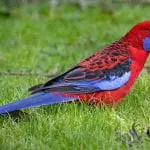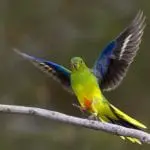Scientific Facts
| Common Name | Eastern Rosella |
| Scientific Name | Platycercus eximius |
| Life Span | 15+ years |
| Size | 30 cm long |
| Habitat | Forests and hills |
| Country of Origin | Australia and Tasmania |
Physical Description
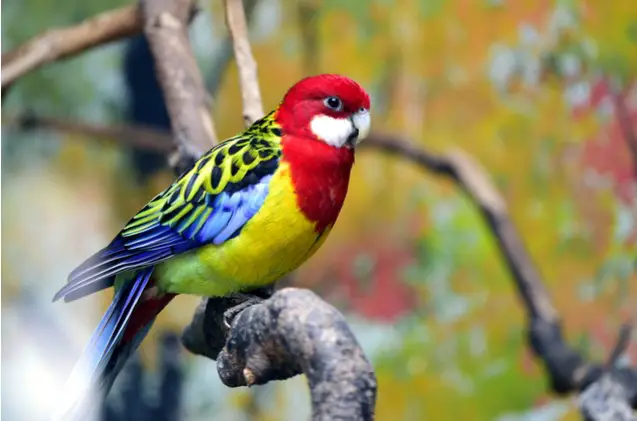
The eastern rosella is a colorful bird native to the southeastern parts of Australia and Tasmania. It has been introduced in New Zealand, where today, large feral populations are found, especially in the North Island. You will also find large flocks in the hills of Dunedin along the South Island.
The eastern rosella measures 30 cm or 12 inches long and may be classified as a medium-sized bird. When held, it can fit in the palm of a large hand. It has a distinct red head and white cheeks, making it look adorable at any angle! It has brown irises which can easily be admired in the daytime. The eastern rosella has a red upper breast and yellow lower breast that fades to a pale green color just above the bird’s abdomen.
The back and shoulder feathers are black with yellowish or greenish edges that create a scalloped look that can vary slightly from one subspecies to another. This area may also vary in males and females. The wings and the lateral tail feathers are blue and white while the tail is a dashing dark green. The legs are grey. Overall, the eastern rosella may be the most colorful bird of all.
The male and female look very similar, but the male tends to be brighter while the female has a duller color. Females also have an underwing band, which is not seen in adult males. Meanwhile, juvenile eastern rosellas are duller compared to females and come with the underwing stripe.
The name “eastern rosella” was given by George Shaw in 1792. It may be considered as a subspecies of the Pale-headed rosella. You may have also heard of the “white-cheeked” rosella, which is a name used for a species that comes with pale-headed and the eastern forms of rosellas.
The hybrid of the two has been observed where their areas meet along the northeastern New South Wales and the southeastern areas in Queensland. A study was published in 2017 found out that the eastern rosella was a part of a lineage of the pale-headed and the northern rosellas.
Subspecies
The eastern rosella has three subspecies recognized by experts
- P. e. eximius – these rosellas are native to Victoria and southern parts of New South Wales. These have black feathers along their backs with green margins. The rump is pale green.
- P. e. elecica – these are found in the northeast parts of New South Wales and southeast areas of Queensland. The male has black feathers on its back with golden yellow edges. The margins are greenish-yellow in females. The rump has a bluish-green color, while the subspecies are called golden-mantled rosella or GMR.
- P. e. diemenensis – this subspecies are native to eastern Tasmania and comes with white patches on its cheeks and are larger than its cousins. The heads of these birds are darker.
Eastern Rosella status
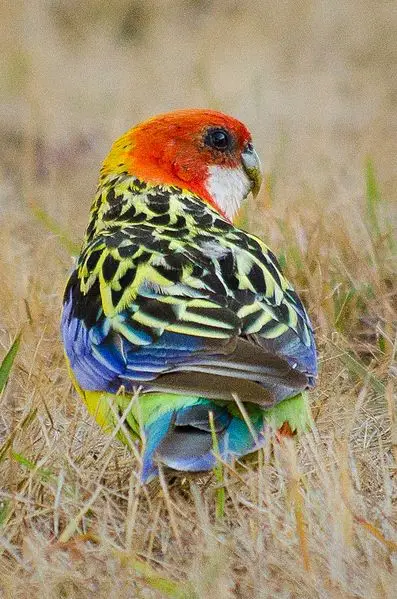
The eastern rosella is classified as a species of least concern by the IUCN. Although these species are in large numbers, the population may still gradually decrease due to habitat destruction and an increase in the pet trade.
This is why we recommend adopting an eastern rosella or buying only from captive breeders instead of buying wild-caught rosellas.
Lifespan
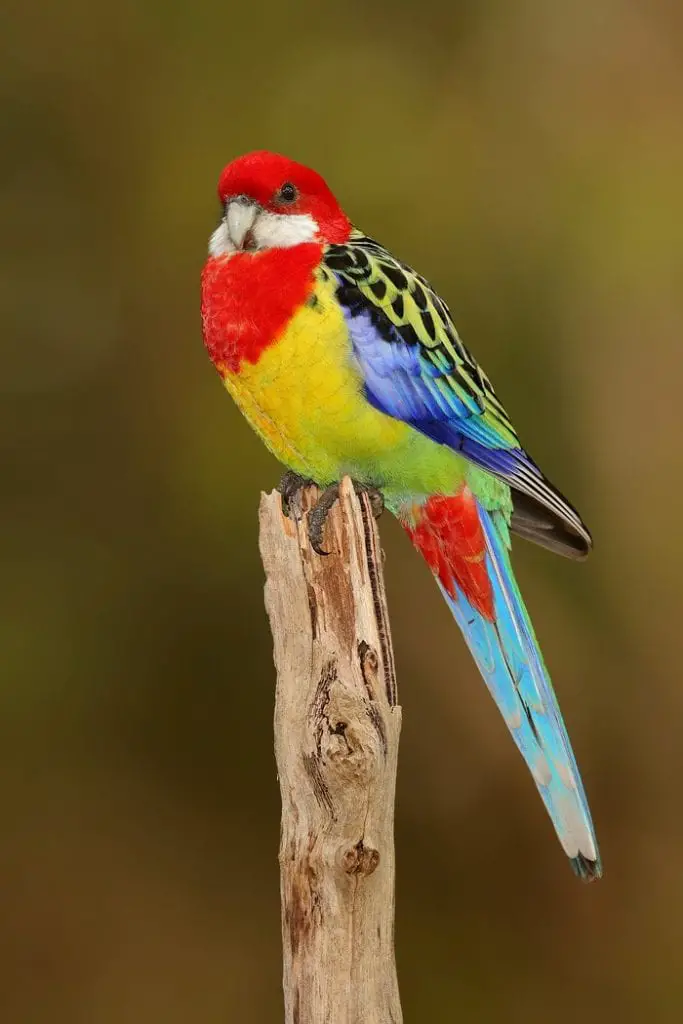
The eastern rosella can live up to 15 years, but it is possible for a captive species to live longer. Because captive birds are protected from the elements and from predators.
Natural Habitat
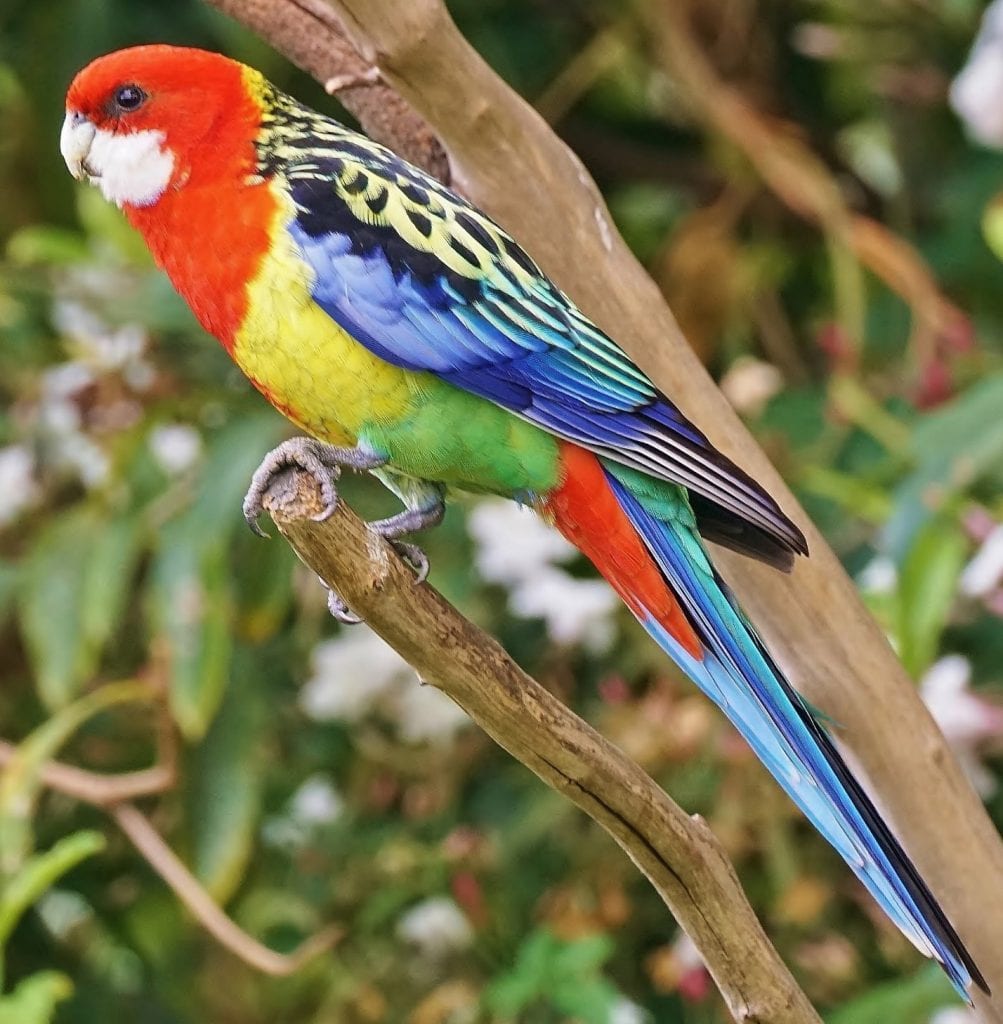
The eastern rosella has a large undisturbed habitat in Australia, Tasmania, and New Zealand. This species is native in areas where there are lightly wooded areas, in open forests, gardens, woodlands, and parks.
This species has become a naturalized bird species in New Zealand. In the 1970s, the number of eastern rosellas started to become established in Auckland, Northland in areas far north even in areas as far as west Waikato, south as Kawhia and areas of Te Kuiti and east of the Coromandel Peninsula.
It is also thought that escaped caged birds started the large population of birds in the Wellington-Hutt Valley Region in the 1960s. Later, these birds scattered along the foothills of the Tararua Range to the east of Eketahuna and west of Otaki.
The first time that eastern rosellas were sighted in New Zealand was in 1940 when a shipment of parrots was refused entry to the country. The Customs Department refused entry and so the birds had to be released before the ship that hauled the birds returned to Sydney. The two eastern rosella species crossed, and in 1955 there were no pure crimson species in the Dunedin area. Rosella populations in Dunedin has always remained low because these are mostly trapped, caged, and sold.
Perception and Communication
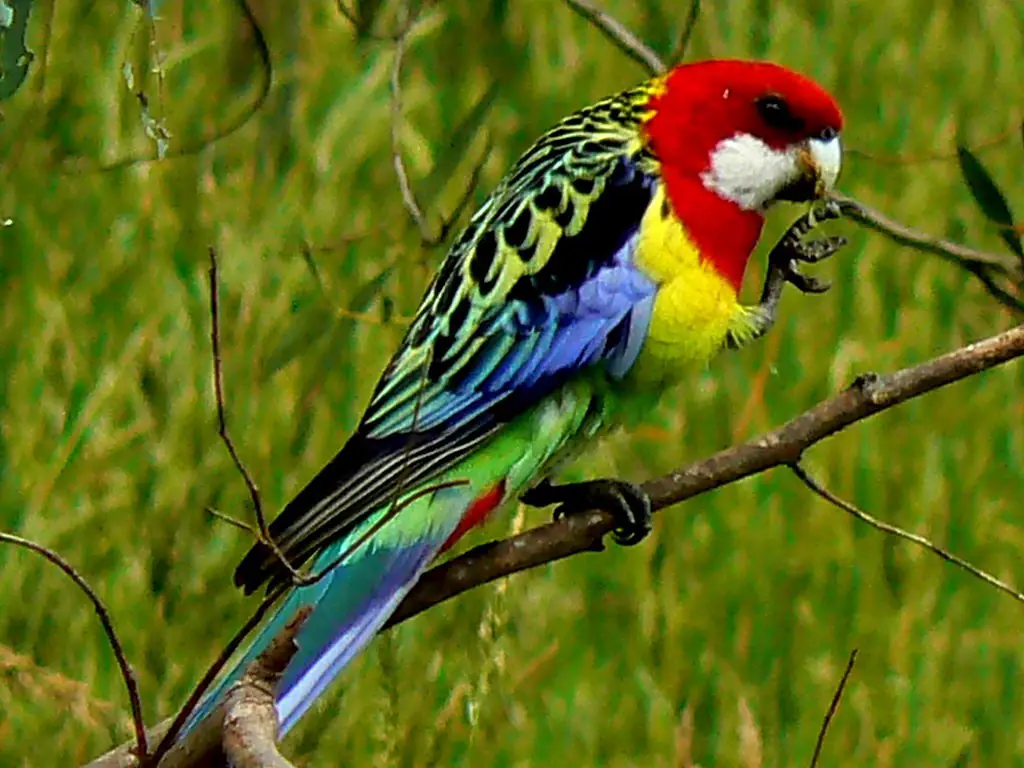
Eastern rosellas don’t mimic human speech, but these are known to mimic other human sounds. It can mimic whistles and may also follow tunes in songs. There are some pet owners who say that eastern rosellas are able to follow them around and surprise them with new sounds each time. However, there are some pet owners that say their birds are very quiet since they got them.
Behavior
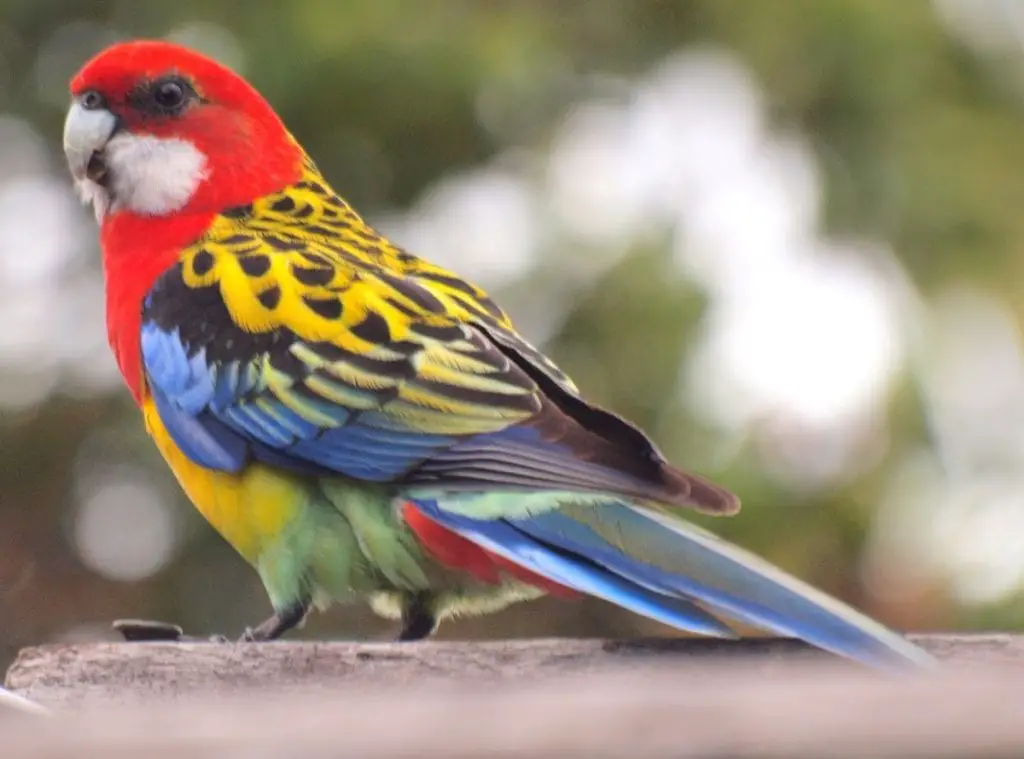
To understand your pet eastern rosella, you must understand it’s many interesting behaviors
Social animals
Eastern rosellas are social animals. Sometimes they can be seen socializing, feeding, and foraging with other rosellas, but sometimes they can be seen alone on a branch. It is common for people to have only one eastern rosella or to take care of only one bird, but actually, these can be better off with other companions.
Preening
Experts believe that a sure sign that the birds are going to have babies is when you see them preening. If you find your birds feeding each other or most especially the male feeding the female using his beak, then it may be a guarantee that the two are going to have babies soon. In some parrot species, preening is also seen in both males and females as a sign of companionship and just being happy to be together.
Good parents
Eastern rosellas are very good parents. When the chicks hatch, these are helpless, naked, and blind, and the mother spends all day with them, getting up from the nest to stretch, poop, and feed, but these are only for a short while. The male, on the other hand, will take food to feed the female since she cannot fly and look for food herself. The two will remain this way even until their chicks are older. The two may soon forage for food and feed their chicks together.
Highly intelligent
This is a very intelligent species since these can mimic sounds and even other kinds of noises and may also recognize their owners. Some owners say that their pets can understand when it’s feeding time and can follow simple commands.
Good companion parrots
Another good quality of this bird is that they make great human companions. These can be handled well, and when given enough time and patience, these can learn simple tricks.
Does not like being petted or cuddled
In some cases, the eastern rosella would not want to be petted or cuddled. This is true, especially for birds that are new to being in captivity. But when you spend time cuddling and petting your pet eastern rosella daily, these will gradually warm up to you.
Can bite
This is sometimes a feisty bird and may bite when it feels threatened. So as much as possible, handle your pet early and do this regularly so it will be used to your handling. Also, other members of your family and other people responsible for your pet’s care should also learn how to handle it properly.
Sometimes feisty
In some cases, the eastern rosella is feisty and just want to be left alone. If you have an eastern rosella and it just does not want anything to do with you or other birds, give it time. Like humans, birds can take time to warm up and will be able to do so in their own time. You can start training when you see it socializing with other birds in the cage, or it is in a brighter mood than usual.
Breeding
Eastern rosellas have some mating and breeding behaviors that are common in most parrot species. One behavior is preening, where a male bird is seen feeding other birds, especially female birds. This social behavior can be seen in mating partners, but some experts say that they also notice this during non-breeding months.
Eastern rosellas breed during the spring but may also do so in the summer months. You will notice bright males showing their lovely sharp colors to woo females, and females usually love being followed around.
When the females cut the chase, they are ready to accept the male. The two mate and soon, the female is ready to deposit her eggs. The most common place to hatch eggs is in a hollow tree. Here, the female will line her nest with twigs, straw, grass, and dirt, and then when the nest is done, delivers 2 to 9 eggs.
The mother will sit on her eggs to warm them and will never leave the nest no matter what. She will warm her eggs and let her soft body rest on the eggs to prevent fluctuations in temperatures. She will never leave the nest and will only do so to defecate, eat a little and to stretch her legs and wings.
The male also helps out by foraging around and preening to the female. The male will come back again and again to feed the female, and when the eggs hatch, both parents will now be responsible for feeding the chick.
The newly-hatched chicks will be born blind, helpless, and naked. It can take more than a week for the birds to open their eyes and another week for the birds to leave their nest.
Food and Diet
Eastern Rosellas are herbivores. Their diet in the wild is composed of seeds, fruits, nuts, and plant parts. This bird may also eat insects, including larvae of insects. This bird may also eat mineral-rich clay which is important in protection against toxins which may be present in their diets
Meanwhile, captive Eastern Rosella eats high-quality, commercially-prepared seed mixes with sunflower, oats, safflower, millets, and hemp seeds. These birds can have a larger, more varied palette in captivity since their owners may also serve them dried berries, vegetables, nuts, and green food.
Captive birds need mineral supplements before and after the breeding season. The most important nutrient is calcium needed for bone health and egg health. Parents also need soft food as they raise their chicks.
You may try feeding your rosellas, “super-seeds”, which are hemp seeds. These seeds have complete amino-acids, omega 3 and 6 fatty acids and other micronutrients. Hemp seeds also have high amounts of protein, which is important for good health and proper overall development.
Environment and Housing

Eastern Rosellas can grow as much as 30 cm long; therefore, it’s best to keep it in a large cage or enclosure. As a rule, the bird must be able to spread its wings without touching any side of the cage. As much as possible, pick a spacious cage made of metal with a large door so you can take the bird in and out with ease. Secure the door with a lock that must be closed at all times.
Inside the cage, sturdy branches must be present where it can perch. You may use natural plants to serve as places where it can sleep or rest. You may also add cage furniture like wooden boxes, swings, vines, mirrors, hoops, and other toys to keep your pet happy and active.
The Eastern Rosella needs a water basin and a container for its food. The container must have a wide mouth so that the bird can easily get its food. The cage may be placed on top of a sturdy surface like a large table or hung from a stand. But no matter what, the cage must be placed away from direct sunlight and rain.
Would you like to take care of two or more Eastern Rosellas? For this, use a large cage or enclosure. You may also have a cage custom-built. The cage should have a bedding of coconut husks, bark, or wood shavings. These materials will absorb urine and odor plus are easy to remove when maintaining the cage. You may also use old newspapers, paper towels, or brown paper as your pet’s bedding.
Cleaning bird cages should be done at least once or two times a month. Remove the bird from the cage and place it in a secure area; you may place it in a separate cage to house it for the meantime.
Clean the cage with water, a scrubber, and some old rags. Remove food and water containers and clean these separately. Use a natural cleaning product that has disinfectant properties to remove dirt and smell. And if there are alive plants and trees inside the cage, remove dry leaves, and care for the tree or plant as you would your pet bird.
Health and Common Issues
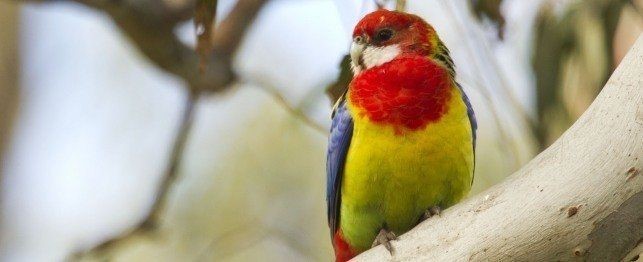
The Eastern Rosella is a healthy and hardy species but is not immune to common health issues. The following
Avian polyomavirus in birds
Avian polyomavirus is an infectious disease that can affect mammals and birds. This is a deadly disease common in young birds. This is highly contagious and may be passed on to other birds through droppings and touching infected birds.
Common symptoms of avian polyomavirus are diarrhea, weight loss, poor appetite, vomiting, swollen abdomen, and dehydration. To prevent avian polyomavirus, have your pet vaccinated against avian polyomavirus. This illness may be spread to humans, so have your pet checked and vaccinated early.
Bird fever or psittacosis in birds
Bird fever is another infectious disease common in most species of birds. This condition may be spread through contact with the droppings of infected specimens. Common symptoms of bird fever are watery and green droppings, discharge from the eyes and nose, difficulty in breathing, lack of appetite, and poor energy.
Bird fever must be treated right away because this is highly-contagious to humans. Also, pet owners should wear proper protective equipment when feeding their pets or cleaning their cages to avoid contracting this illness, especially when you suspect that your pet has it.
Malnutrition
Birds with an imbalanced diet or don’t get nutrients from their diet may be suffering from malnutrition. Any of the illnesses mentioned may also contribute to malnutrition. Signs are lack of energy, feather stress bars, and dark feather colors.
To avoid malnutrition, your bird should get enough sunlight, especially when their cage is placed indoors. Use artificial birdcage lighting if you can’t take the bird outdoors.
Also, be very careful in changing the bird’s diet. Usually, birds may not eat new food and may starve. Take your bird to a vet to examine it for malnutrition after you have changed its diet.
Pacheco’s disease in birds
Pacheco’s disease is another dangerous disease caused by a type of herpes virus. The infected bird may spread this disease through contact with infected droppings and nasal discharges. The virus could stay dormant in birds but become activated when it is in stress.
Some stressful situations are moving, the death of a partner, and breeding. Symptoms include tremors, sinusitis, green-colored droppings, lethargy, anorexia, and death. Prevent the spread of Pacheco’s disease by placing suspected birds in quarantine. This is not contagious to humans but only to other birds in the cage or enclosure.
Giardia in birds
This is a parasitic infection that could be spread from one infected bird to another through cysts present in the bird’s feces. Usually, the cause is unclean water supply and may be passed on to humans if they drink from the same water source. Symptoms include diarrhea, weight loss, dry and itchy skin, and constipation. If you suspect giardia, take your bird to the vet as soon as you spot any symptoms.
Aside from the mentioned common health conditions, don’t hesitate to take your bird to the vet if you spot any of the following: Any strange appearance or stance like excessive plucking of feathers, hanging using its beak, trembling, walking in circles, changes in behavior or attitude and other physical changes. Note any change in its droppings, breathing, eating, head shape, feathers, legs, and feet should be reported immediately to the vet. Early prevention can prevent many diseases.
Preventive Care
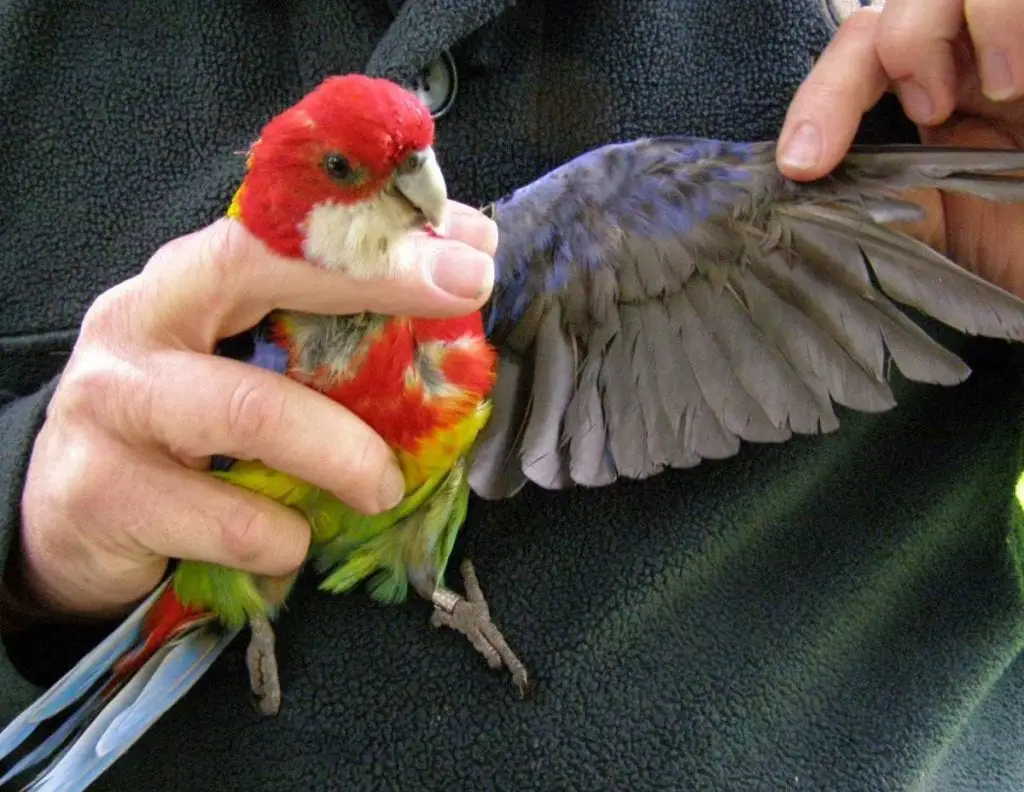
Just like any pet bird, eastern rosellas must undergo a complete physical examination once every 6 to 12 months. Take it to an avian veterinarian for proper care. If you have any concerns about the health of your bird, don’t hesitate to ask and avian vet. If this professional is not available in your area, consult a general vet, and get recommendations.
Your pet should take an annual fecal examination for possible yeast, parasites, and bacterial infection. Your pet may also receive vaccinations for polyomavirus and routine blood testing to make sure he’s negative for these common health conditions.
Eastern rosellas must have their nails and wings trimmed, and only an avian vet can help get these done with ease. You must also clean your bird’s cage regularly. Remove uneaten food, droppings, and wash the cage with a safe cleaning product or natural products. Clean the feeding and drinking dishes and all the bird’s toys and cage furniture as well. Doing these can help prevent the spread of illnesses and other health conditions.
Availability – Where to Get One?
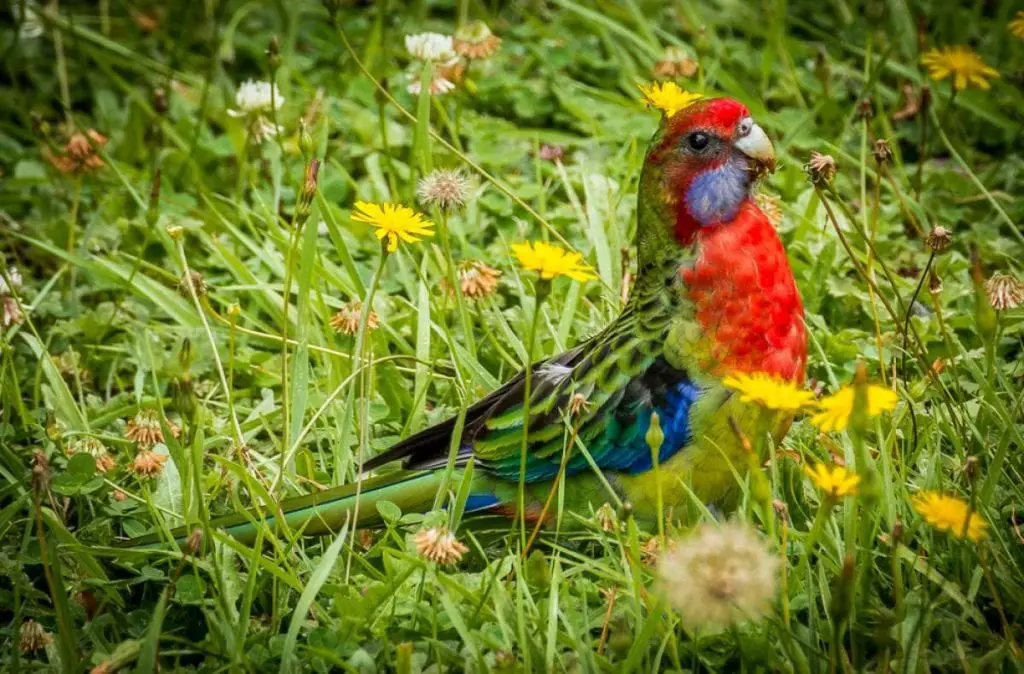
Eastern Rosellas are available for sale from a local breeder, or an avian pet store near you. You can purchase these from online exotic pet shops. The price for an Eastern Rosella online is from $100 to $200 depending on the gender, age, and overall appearance of the bird. This is one of the most expensive birds because of their lovely, exotic appearance.
Eastern Rosellas and other exotic birds are also available for adoption from bird adoption or rescue organizations. These groups help birds like rosellas find new and loving families and homes.
How to Care for an Eastern Rosella
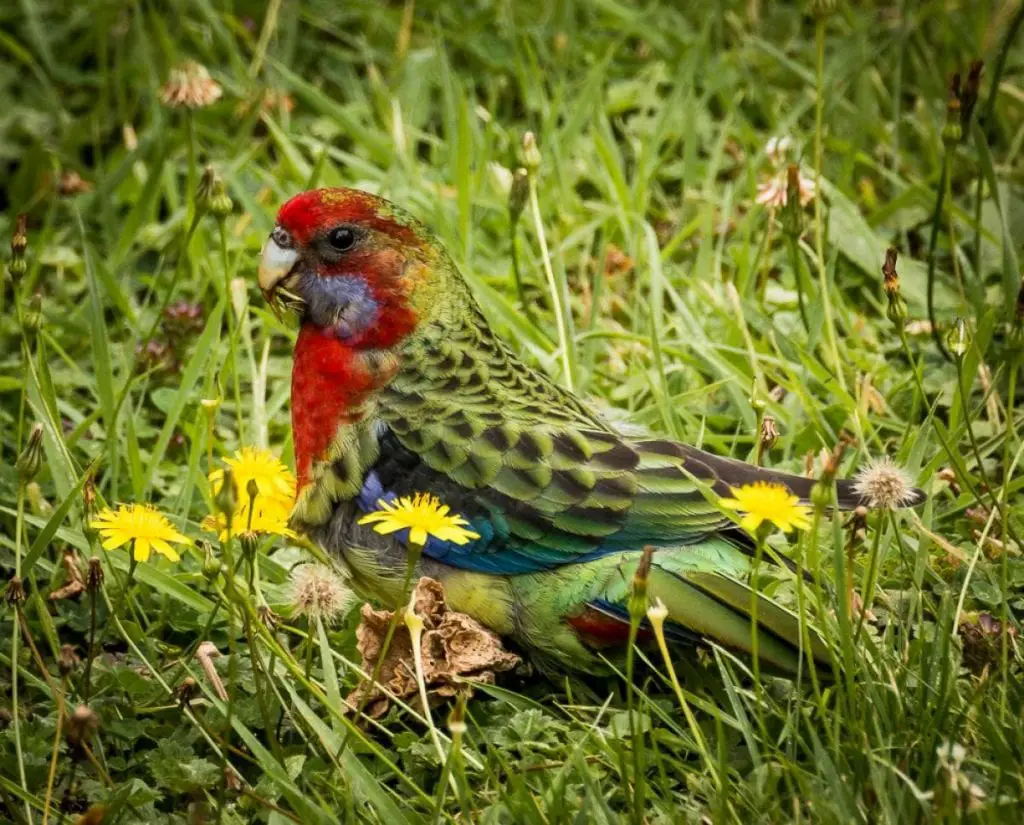
Eastern Rosellas have distinct physiologies and have unique requirements. Aside from interacting with your pet must commit to two hours of every day cage maintenance and feeding. You must never overlook caring for your pet bird because this will help develop your pet’s mental and physical condition.
Place your pet in a good-sized cage that’s comfortable and safe. The cage should be big enough to allow your bird to spread his wings without touching cage bars on either side. When creating a home for two or more birds, use a very large cage or a custom-made cage. Add natural branch perches and cage toys like woven toys, hoops, balls, mirrors, swings, and other similar items.
Always hold your pet regularly. This will create an improved bond between you and your pet. This bird looks delicate, but you’ll learn to handle it in no time. Use a glove to protect your hands from the bird’s sharp claws because, despite its size, the claws can be sharp. Also, teach other people who will be caring for your bird how to effectively hold it.
And when it comes to feeding a pet eastern rosella, give it appropriate bird food. You can use commercially-prepared food, fruits, and vegetable, but make sure you’re serving organic produce. Have a fixed feeding schedule so your pet won’t suffer from obesity and other conditions related to being overweight.
FAQs
What do eastern rosellas eat?
Eastern rosellas can eat plants but can also nibble on small insects. In captivity, these birds can eat commercially-prepared food, nuts, seeds, plant parts, vegetables, and fruits; be careful when changing their diet because these birds may not eat when their food is changed.
Can you feed eastern rosellas fruit and vegetables?
Captive rosellas will eat fruits and vegetables. They will eat local produce, but it’s best to give them organic food, so these are free from pesticides, herbicides, and toxins.
How do eastern rosellas drink water?
You can place water in a large container and just let the bird hop in or stay on edge to take a sip. You may also offer water-rich foods like fruits and vegetables, so they will have enough water in their diet.
Can you give eastern rosellas treats?
It depends on what treats you’re talking about. If you are referring to candy or chocolates, then this is a no-no. Offer fruits as a treat or how about pureed fruits like jams. Place treats on the tip of a stick and just offer this when your pet has done a good job just like you would give a treat to a dog or cat.
How do you place eastern rosella food inside the cage?
An eastern rosella can take food from a dish. If you’re housing two or more birds in one cage, place food in a wide mouth heavy bowl. The birds will come together and eat here, and this can be a good way to enhance the social behavior of your pet.
Can eastern rosellas drink from a pot of water?
Yes, rosellas can drink socially as well. Place water in a heavy pot and just let this remain in the middle of the cage. The birds will come and drink or may even use this to take a splash of water.
Will eastern rosellas eat cookies?
Yes, they may eat cookies but offer them organic made cookies and not chocolate chip, mint, or other store-bought cookies that may contain ingredients that are not good for your pets.
Where do you place the cage of your eastern rosellas?
Choose an indoor or outdoor setting for your birdcage. No matter what setup you chose, the cage must not be exposed to direct sunlight and must have a good roof to avoid rain from coming in.
How do you clean the cage of eastern rosellas?
To clean the cage of eastern rosellas, remove the bird and hose down the cage to remove dirt, food remnants, poop, and pee. Remove and replace the bedding to clean the cage completely. Using natural cleaning products allows you to clean without affecting the health of your pet.
Are eastern rosellas related to common rosellas?
Yes, eastern rosellas are related to common rosellas in a way that eastern rosellas are their close relative. If you compare the two, you can see that both have almost the same plumage, the shape of the body, head, and bill and may also have the same behavior and temperament.
Can you house two to three different rosella species in one cage?
Yes, you can house two or three or even more rosellas in one cage. Rosellas are like other parrots that they can socialize well with the same and different species.
Are eastern rosellas territorial?
No, eastern rosellas are not territorial. They will not compete for territory, but they may compete for a mate. Some rosellas may fight till the death if this is what it takes to get a female.
Will eastern rosellas males fight over females?
Yes, eastern rosellas can fight for a female, and this usually ends up with one male bloodied and weak.
Will eastern rosellas bite?
Yes, these birds may bite when they feel threatened. To avoid this, interact with your pet frequently. Don’t just leave your pet on its own inside its cage. But do give your pet some time to grow accustomed to its cage or a new environment, and surely it will warm up to you in no time.
Do eastern rosellas have sharp claws?
Yes, eastern rosellas have sharp claws, and they can use this to defend themselves. So don’t make your pet angry or irritate it; maintain a calm environment so sit can avoid aggressive behavior.
Can eastern rosellas pluck their feathers?
Feather plucking is a common sign that your pet is stressed. Sometimes, stress can be too much to your pet, and thus it can pluck its feathers too much, creating bald spots and areas on its body and wings. To stop this,
Can you place a pair of male and female eastern rosellas together in one cage?
Yes, you can place a pair of male and female eastern rosellas in one cage, but come breeding time, these two will likely mate. You may also place two males and two females or have a cage with several males and females as long as the cage is large and can accommodate all your pet birds.
When are eastern rosellas ready to mate?
Eastern rosellas are ready to mate in just a few months after birth. Females mature earlier than males and are larger than their male counterparts. Females are duller than males as well.
How many eggs do eastern rosellas lay?
Eastern rosellas can lay from 3 to 5 eggs in a clutch. You can tell that the female is ready to lay her eggs when she is arranging her nest; she will use grass, twigs, mud and dried leaves and will make their nests in empty or hollow tree trunks
Can you take the eggs of an eastern rosella from the wild to raise them?
Yes, you can take eggs from a nest of a wild eastern rosella and incubate them at home, provided you incubate these properly. Place the eggs in a warm and safe environment.
How do you incubate the eggs of an eastern rosella?
Prepare a nest made from soft old clothes and place these inside a shoebox. Place the eggs under strong warm lighting and keep these wrapped in cloth. These will hatch in a week or so.
Are eastern rosella males helpful in feeding their young?
Yes, eastern rosella males are also involved in raising his offspring. He does this by foraging for food and taking the food to feed his mate. Since the female cannot leave the nest, the male has to bring her food and preen with her.
Are female eastern rosellas protective of her young?
Yes, the female eastern rosellas are very protective of her newborns by not leaving the nest. She will only get out of the nest to stretch, eat a little and defecate, but other than this, she is on patrol all day and all night.
How long with an eastern rosella egg hatch?
The eggs of an eastern rosella will hatch in just a week or two, and this depends on the temperature and the readiness of the chick to hatch. The eggs are usually round and are white to pale white in color, and when chicks hatch these are naked, blind and helpless.
What happens if your eastern rosellas won’t mate?
If your eastern rosella doesn’t mate, give it time. It may need to wait till the next breeding season to mate. And of course, consider that every bird has its own time, and your pet may just be waiting for his or her time as well.
How young do chicks leave the nest?
Just like most parrots, the eastern rosella chick may leave after it has grown all his feathers and are able to fly successfully. It can take four to five weeks for a chick to leave, and usually, the eldest chick is the first one to do so.
Are eastern rosellas ready to fly when they leave the nest?
Usually, eastern rosellas are ready to fly when they leave the nest. They have to learn how to fly because this is their means to escape predators and look for food. A chick that’s unable to fly may find himself alone in his nest as his parents have already left thinking that their babies are already ready to live on their own.
Where can I find eastern rosella nests?
Eastern rosella nests are mostly found in trees, especially in trees with a hollow portion. The birds will use this hole to make a nest; the mother will line the nest with soft items like grass, mud, small stems, and leaves to make it more comfortable and cold-resistant.
How do females make their nests?
Females will usually use anything to make their nests, but if given a wide variety of materials, the female will use twigs, hay, mud, stems, tree bark, leaves, and other handy building material as their nest.
Will female eastern rosellas eat their young?
Some pet owners have noticed this behavior in most parrot species, but they are unaware of why it is done. Most say that this is a way for the bird to show their insecurity. Some say that this is a sign of dominance, but no matter what, remove the female or male that does this and just care for the eggs instead. Females who do this should not be allowed to breed.
How do eastern rosellas look for food?
Eastern rosellas forage for food; they may look food in trees, on forest grounds, or near water sources since this is where insects abound.
Do eastern rosellas have other colors?
No, eastern rosellas don’t have any other color combinations. The red head and colorful body, wings, and abdomen are similar to all eastern rosellas.
How can you tell male from female eastern rosellas?
Female rosellas and male rosellas seem to be very similar, but actually, there are some slight differences. Males have brighter colors, while females are dull in appearance. Males are also smaller than females. You may also ask a vet to determine the gender of your pet eastern rosella.

